Case Study Analysis: Ryanair - Context of Business Module
VerifiedAdded on 2022/08/12
|17
|4379
|491
Case Study
AI Summary
This case study analyzes Ryanair, a major low-cost airline, examining its internal and external environments. It begins with an overview of Ryanair, highlighting its growth and market position. The study then conducts a SWOT analysis, identifying the airline's strengths (low cost, strong balance sheet), weaknesses (employee relations, seasonality), opportunities (expanding network, improved customer service), and threats (Brexit, fuel prices, competition). A PESTLE analysis follows, assessing the political (Brexit, air travel tax), economic (GBP devaluation), social (demand for holidays), technological (online services), legal (aviation regulations), and environmental (sustainable practices) factors affecting Ryanair. The study identifies key problems, including poor customer service, employee relations, and the impact of Brexit. It proposes a solution based on Herzberg's two-factor theory of motivation, emphasizing the importance of both hygiene and motivator factors to address labor issues and improve employee satisfaction. The analysis concludes with a recommendation to enhance employee motivation through improved benefits and effective leadership to mitigate labor issues and improve overall performance.
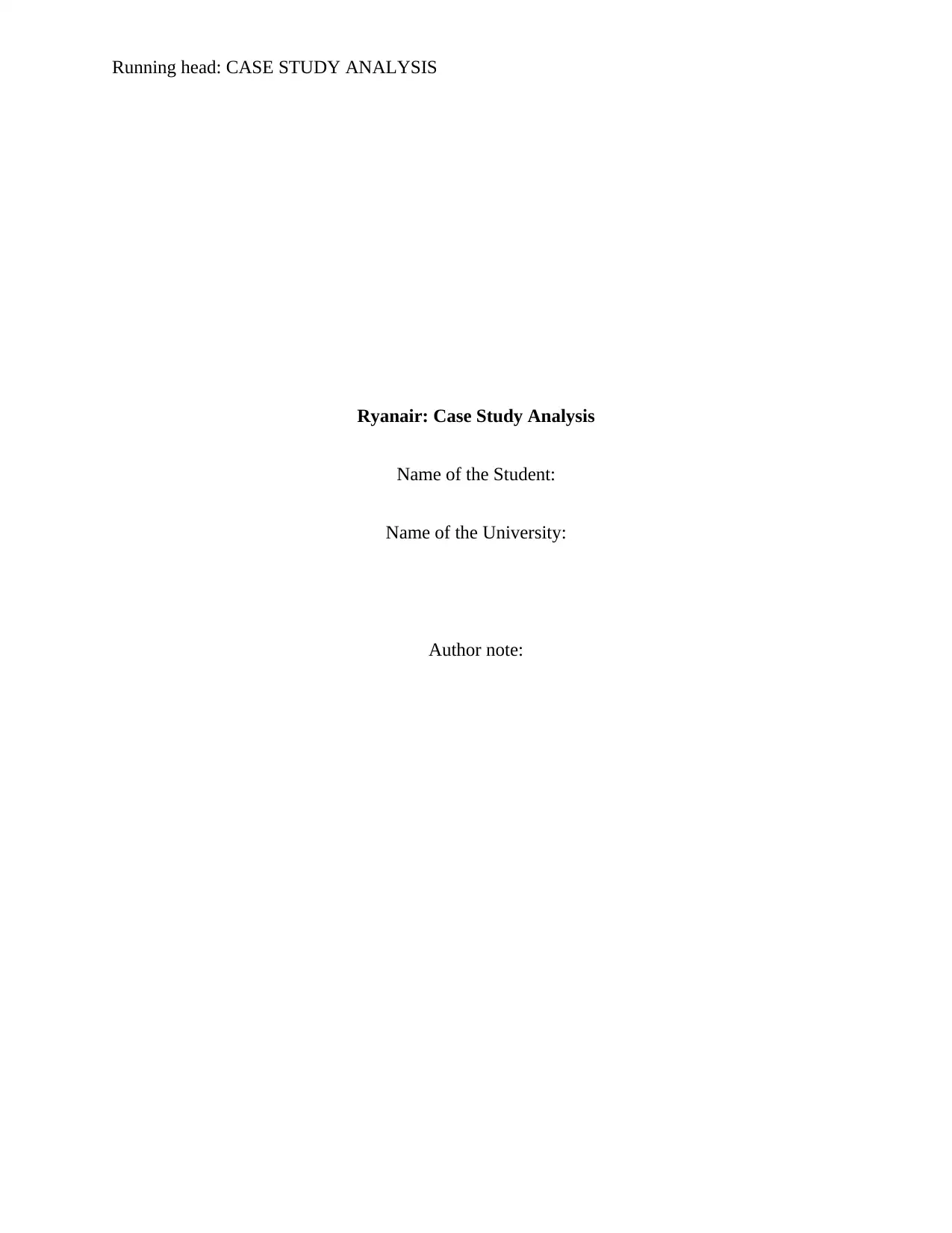
Running head: CASE STUDY ANALYSIS
Ryanair: Case Study Analysis
Name of the Student:
Name of the University:
Author note:
Ryanair: Case Study Analysis
Name of the Student:
Name of the University:
Author note:
Paraphrase This Document
Need a fresh take? Get an instant paraphrase of this document with our AI Paraphraser
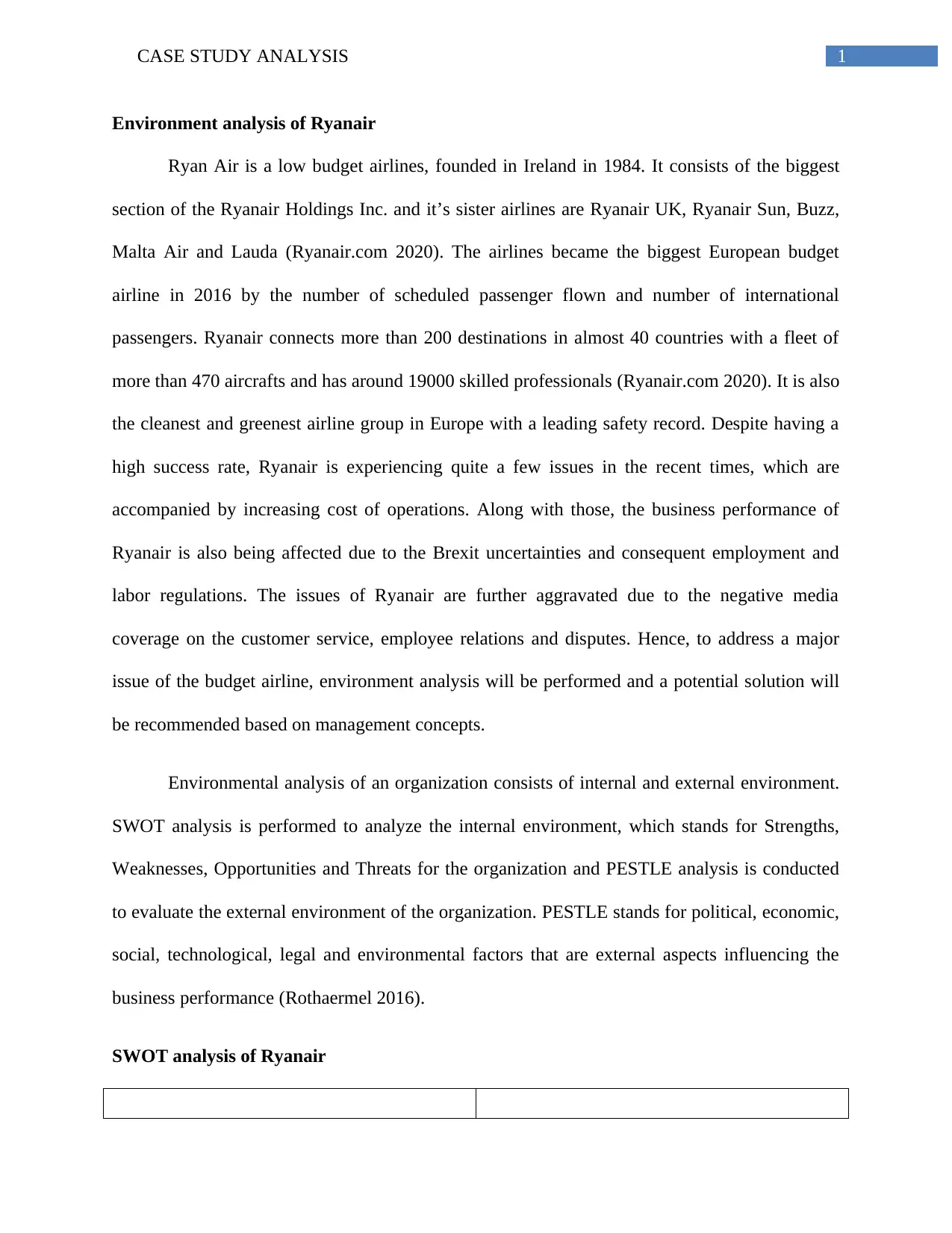
1CASE STUDY ANALYSIS
Environment analysis of Ryanair
Ryan Air is a low budget airlines, founded in Ireland in 1984. It consists of the biggest
section of the Ryanair Holdings Inc. and it’s sister airlines are Ryanair UK, Ryanair Sun, Buzz,
Malta Air and Lauda (Ryanair.com 2020). The airlines became the biggest European budget
airline in 2016 by the number of scheduled passenger flown and number of international
passengers. Ryanair connects more than 200 destinations in almost 40 countries with a fleet of
more than 470 aircrafts and has around 19000 skilled professionals (Ryanair.com 2020). It is also
the cleanest and greenest airline group in Europe with a leading safety record. Despite having a
high success rate, Ryanair is experiencing quite a few issues in the recent times, which are
accompanied by increasing cost of operations. Along with those, the business performance of
Ryanair is also being affected due to the Brexit uncertainties and consequent employment and
labor regulations. The issues of Ryanair are further aggravated due to the negative media
coverage on the customer service, employee relations and disputes. Hence, to address a major
issue of the budget airline, environment analysis will be performed and a potential solution will
be recommended based on management concepts.
Environmental analysis of an organization consists of internal and external environment.
SWOT analysis is performed to analyze the internal environment, which stands for Strengths,
Weaknesses, Opportunities and Threats for the organization and PESTLE analysis is conducted
to evaluate the external environment of the organization. PESTLE stands for political, economic,
social, technological, legal and environmental factors that are external aspects influencing the
business performance (Rothaermel 2016).
SWOT analysis of Ryanair
Environment analysis of Ryanair
Ryan Air is a low budget airlines, founded in Ireland in 1984. It consists of the biggest
section of the Ryanair Holdings Inc. and it’s sister airlines are Ryanair UK, Ryanair Sun, Buzz,
Malta Air and Lauda (Ryanair.com 2020). The airlines became the biggest European budget
airline in 2016 by the number of scheduled passenger flown and number of international
passengers. Ryanair connects more than 200 destinations in almost 40 countries with a fleet of
more than 470 aircrafts and has around 19000 skilled professionals (Ryanair.com 2020). It is also
the cleanest and greenest airline group in Europe with a leading safety record. Despite having a
high success rate, Ryanair is experiencing quite a few issues in the recent times, which are
accompanied by increasing cost of operations. Along with those, the business performance of
Ryanair is also being affected due to the Brexit uncertainties and consequent employment and
labor regulations. The issues of Ryanair are further aggravated due to the negative media
coverage on the customer service, employee relations and disputes. Hence, to address a major
issue of the budget airline, environment analysis will be performed and a potential solution will
be recommended based on management concepts.
Environmental analysis of an organization consists of internal and external environment.
SWOT analysis is performed to analyze the internal environment, which stands for Strengths,
Weaknesses, Opportunities and Threats for the organization and PESTLE analysis is conducted
to evaluate the external environment of the organization. PESTLE stands for political, economic,
social, technological, legal and environmental factors that are external aspects influencing the
business performance (Rothaermel 2016).
SWOT analysis of Ryanair
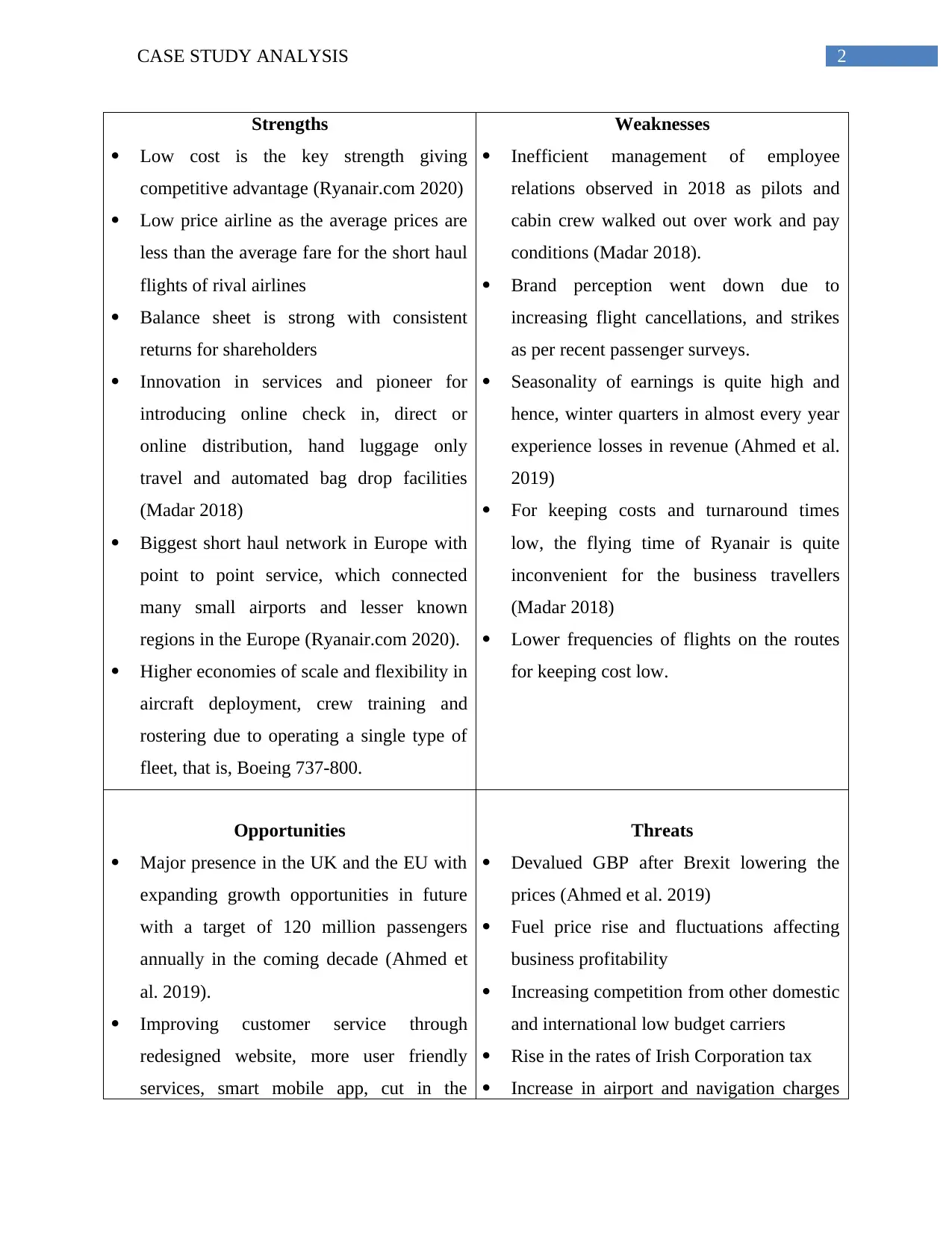
2CASE STUDY ANALYSIS
Strengths
Low cost is the key strength giving
competitive advantage (Ryanair.com 2020)
Low price airline as the average prices are
less than the average fare for the short haul
flights of rival airlines
Balance sheet is strong with consistent
returns for shareholders
Innovation in services and pioneer for
introducing online check in, direct or
online distribution, hand luggage only
travel and automated bag drop facilities
(Madar 2018)
Biggest short haul network in Europe with
point to point service, which connected
many small airports and lesser known
regions in the Europe (Ryanair.com 2020).
Higher economies of scale and flexibility in
aircraft deployment, crew training and
rostering due to operating a single type of
fleet, that is, Boeing 737-800.
Weaknesses
Inefficient management of employee
relations observed in 2018 as pilots and
cabin crew walked out over work and pay
conditions (Madar 2018).
Brand perception went down due to
increasing flight cancellations, and strikes
as per recent passenger surveys.
Seasonality of earnings is quite high and
hence, winter quarters in almost every year
experience losses in revenue (Ahmed et al.
2019)
For keeping costs and turnaround times
low, the flying time of Ryanair is quite
inconvenient for the business travellers
(Madar 2018)
Lower frequencies of flights on the routes
for keeping cost low.
Opportunities
Major presence in the UK and the EU with
expanding growth opportunities in future
with a target of 120 million passengers
annually in the coming decade (Ahmed et
al. 2019).
Improving customer service through
redesigned website, more user friendly
services, smart mobile app, cut in the
Threats
Devalued GBP after Brexit lowering the
prices (Ahmed et al. 2019)
Fuel price rise and fluctuations affecting
business profitability
Increasing competition from other domestic
and international low budget carriers
Rise in the rates of Irish Corporation tax
Increase in airport and navigation charges
Strengths
Low cost is the key strength giving
competitive advantage (Ryanair.com 2020)
Low price airline as the average prices are
less than the average fare for the short haul
flights of rival airlines
Balance sheet is strong with consistent
returns for shareholders
Innovation in services and pioneer for
introducing online check in, direct or
online distribution, hand luggage only
travel and automated bag drop facilities
(Madar 2018)
Biggest short haul network in Europe with
point to point service, which connected
many small airports and lesser known
regions in the Europe (Ryanair.com 2020).
Higher economies of scale and flexibility in
aircraft deployment, crew training and
rostering due to operating a single type of
fleet, that is, Boeing 737-800.
Weaknesses
Inefficient management of employee
relations observed in 2018 as pilots and
cabin crew walked out over work and pay
conditions (Madar 2018).
Brand perception went down due to
increasing flight cancellations, and strikes
as per recent passenger surveys.
Seasonality of earnings is quite high and
hence, winter quarters in almost every year
experience losses in revenue (Ahmed et al.
2019)
For keeping costs and turnaround times
low, the flying time of Ryanair is quite
inconvenient for the business travellers
(Madar 2018)
Lower frequencies of flights on the routes
for keeping cost low.
Opportunities
Major presence in the UK and the EU with
expanding growth opportunities in future
with a target of 120 million passengers
annually in the coming decade (Ahmed et
al. 2019).
Improving customer service through
redesigned website, more user friendly
services, smart mobile app, cut in the
Threats
Devalued GBP after Brexit lowering the
prices (Ahmed et al. 2019)
Fuel price rise and fluctuations affecting
business profitability
Increasing competition from other domestic
and international low budget carriers
Rise in the rates of Irish Corporation tax
Increase in airport and navigation charges
⊘ This is a preview!⊘
Do you want full access?
Subscribe today to unlock all pages.

Trusted by 1+ million students worldwide
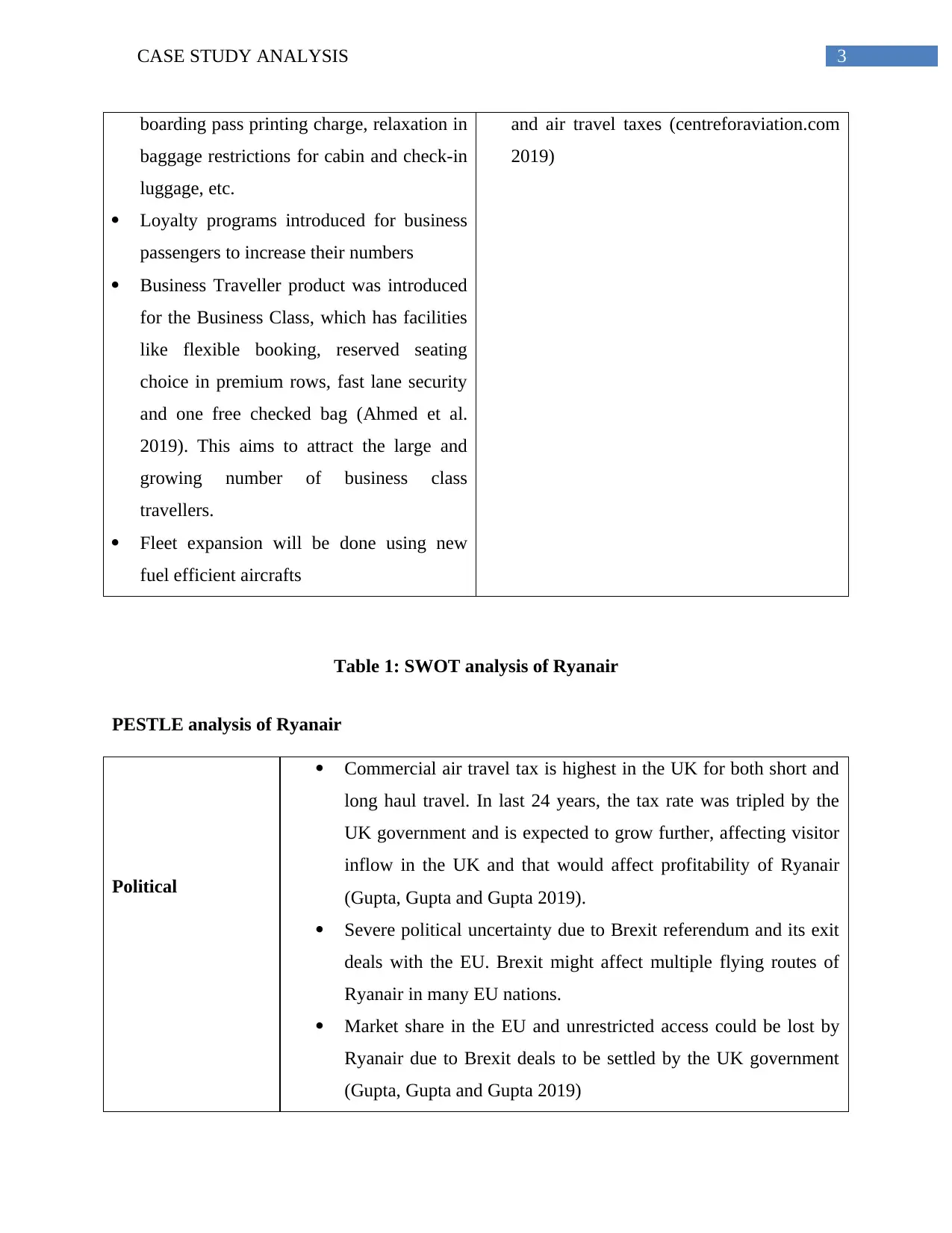
3CASE STUDY ANALYSIS
boarding pass printing charge, relaxation in
baggage restrictions for cabin and check-in
luggage, etc.
Loyalty programs introduced for business
passengers to increase their numbers
Business Traveller product was introduced
for the Business Class, which has facilities
like flexible booking, reserved seating
choice in premium rows, fast lane security
and one free checked bag (Ahmed et al.
2019). This aims to attract the large and
growing number of business class
travellers.
Fleet expansion will be done using new
fuel efficient aircrafts
and air travel taxes (centreforaviation.com
2019)
Table 1: SWOT analysis of Ryanair
PESTLE analysis of Ryanair
Political
Commercial air travel tax is highest in the UK for both short and
long haul travel. In last 24 years, the tax rate was tripled by the
UK government and is expected to grow further, affecting visitor
inflow in the UK and that would affect profitability of Ryanair
(Gupta, Gupta and Gupta 2019).
Severe political uncertainty due to Brexit referendum and its exit
deals with the EU. Brexit might affect multiple flying routes of
Ryanair in many EU nations.
Market share in the EU and unrestricted access could be lost by
Ryanair due to Brexit deals to be settled by the UK government
(Gupta, Gupta and Gupta 2019)
boarding pass printing charge, relaxation in
baggage restrictions for cabin and check-in
luggage, etc.
Loyalty programs introduced for business
passengers to increase their numbers
Business Traveller product was introduced
for the Business Class, which has facilities
like flexible booking, reserved seating
choice in premium rows, fast lane security
and one free checked bag (Ahmed et al.
2019). This aims to attract the large and
growing number of business class
travellers.
Fleet expansion will be done using new
fuel efficient aircrafts
and air travel taxes (centreforaviation.com
2019)
Table 1: SWOT analysis of Ryanair
PESTLE analysis of Ryanair
Political
Commercial air travel tax is highest in the UK for both short and
long haul travel. In last 24 years, the tax rate was tripled by the
UK government and is expected to grow further, affecting visitor
inflow in the UK and that would affect profitability of Ryanair
(Gupta, Gupta and Gupta 2019).
Severe political uncertainty due to Brexit referendum and its exit
deals with the EU. Brexit might affect multiple flying routes of
Ryanair in many EU nations.
Market share in the EU and unrestricted access could be lost by
Ryanair due to Brexit deals to be settled by the UK government
(Gupta, Gupta and Gupta 2019)
Paraphrase This Document
Need a fresh take? Get an instant paraphrase of this document with our AI Paraphraser
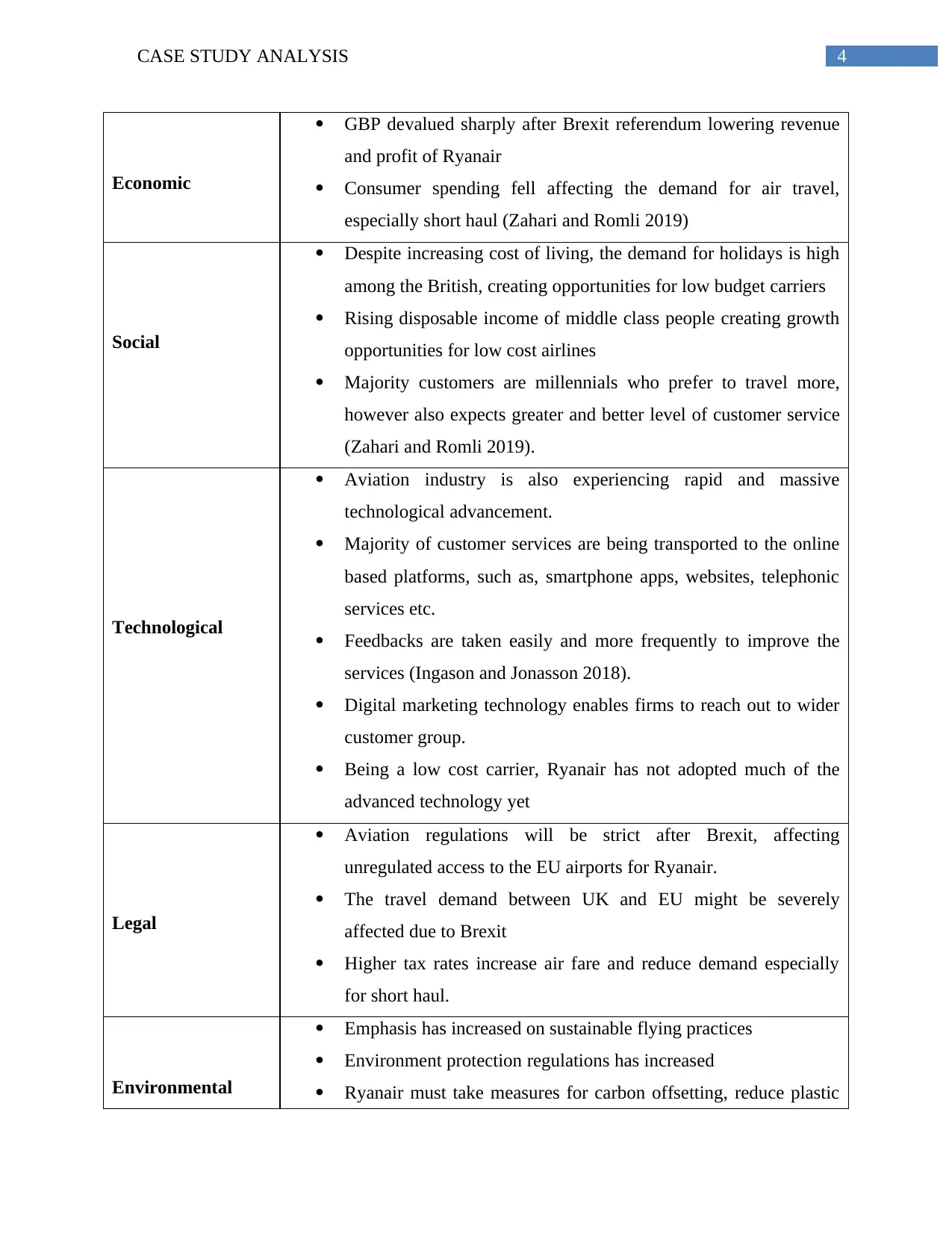
4CASE STUDY ANALYSIS
Economic
GBP devalued sharply after Brexit referendum lowering revenue
and profit of Ryanair
Consumer spending fell affecting the demand for air travel,
especially short haul (Zahari and Romli 2019)
Social
Despite increasing cost of living, the demand for holidays is high
among the British, creating opportunities for low budget carriers
Rising disposable income of middle class people creating growth
opportunities for low cost airlines
Majority customers are millennials who prefer to travel more,
however also expects greater and better level of customer service
(Zahari and Romli 2019).
Technological
Aviation industry is also experiencing rapid and massive
technological advancement.
Majority of customer services are being transported to the online
based platforms, such as, smartphone apps, websites, telephonic
services etc.
Feedbacks are taken easily and more frequently to improve the
services (Ingason and Jonasson 2018).
Digital marketing technology enables firms to reach out to wider
customer group.
Being a low cost carrier, Ryanair has not adopted much of the
advanced technology yet
Legal
Aviation regulations will be strict after Brexit, affecting
unregulated access to the EU airports for Ryanair.
The travel demand between UK and EU might be severely
affected due to Brexit
Higher tax rates increase air fare and reduce demand especially
for short haul.
Environmental
Emphasis has increased on sustainable flying practices
Environment protection regulations has increased
Ryanair must take measures for carbon offsetting, reduce plastic
Economic
GBP devalued sharply after Brexit referendum lowering revenue
and profit of Ryanair
Consumer spending fell affecting the demand for air travel,
especially short haul (Zahari and Romli 2019)
Social
Despite increasing cost of living, the demand for holidays is high
among the British, creating opportunities for low budget carriers
Rising disposable income of middle class people creating growth
opportunities for low cost airlines
Majority customers are millennials who prefer to travel more,
however also expects greater and better level of customer service
(Zahari and Romli 2019).
Technological
Aviation industry is also experiencing rapid and massive
technological advancement.
Majority of customer services are being transported to the online
based platforms, such as, smartphone apps, websites, telephonic
services etc.
Feedbacks are taken easily and more frequently to improve the
services (Ingason and Jonasson 2018).
Digital marketing technology enables firms to reach out to wider
customer group.
Being a low cost carrier, Ryanair has not adopted much of the
advanced technology yet
Legal
Aviation regulations will be strict after Brexit, affecting
unregulated access to the EU airports for Ryanair.
The travel demand between UK and EU might be severely
affected due to Brexit
Higher tax rates increase air fare and reduce demand especially
for short haul.
Environmental
Emphasis has increased on sustainable flying practices
Environment protection regulations has increased
Ryanair must take measures for carbon offsetting, reduce plastic
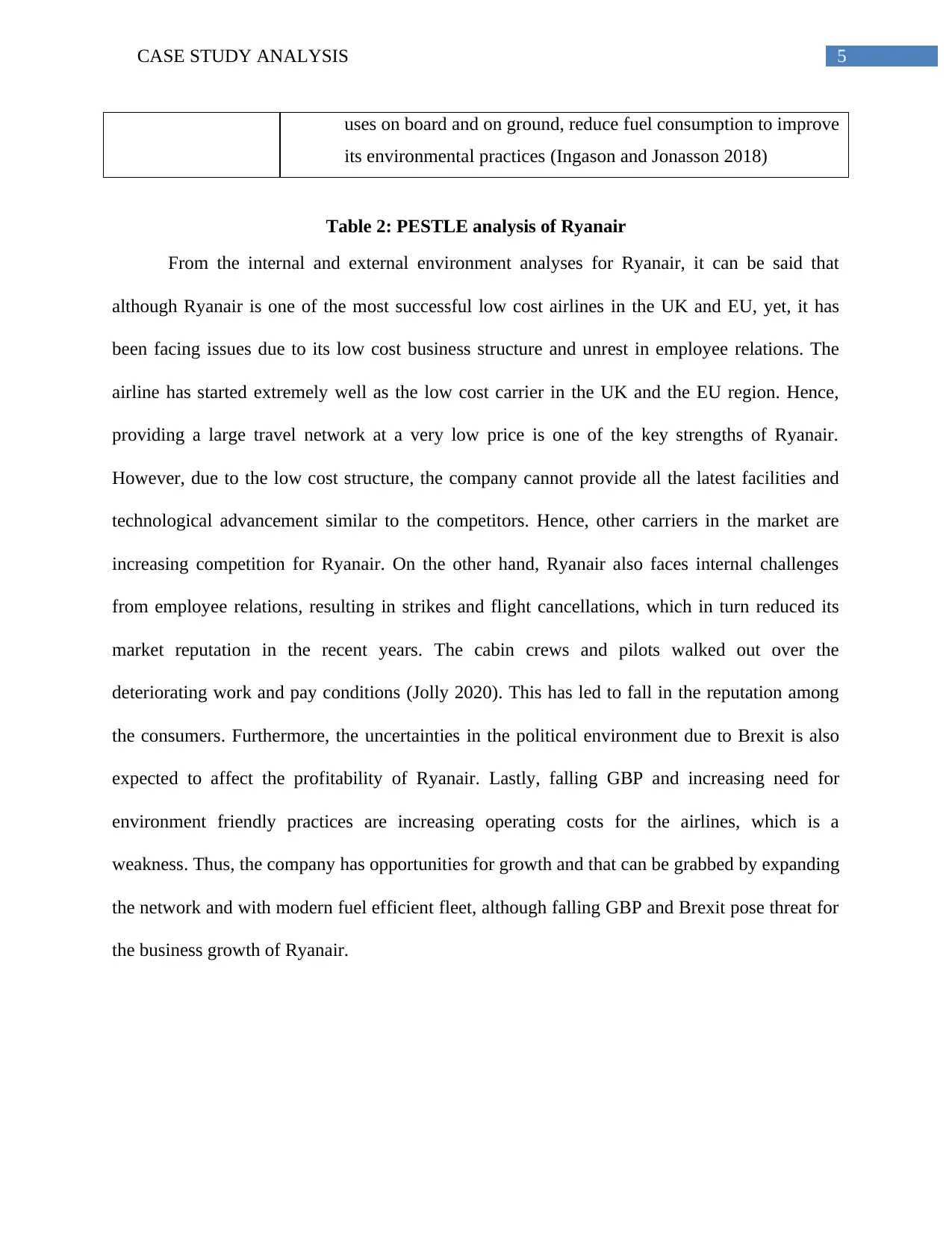
5CASE STUDY ANALYSIS
uses on board and on ground, reduce fuel consumption to improve
its environmental practices (Ingason and Jonasson 2018)
Table 2: PESTLE analysis of Ryanair
From the internal and external environment analyses for Ryanair, it can be said that
although Ryanair is one of the most successful low cost airlines in the UK and EU, yet, it has
been facing issues due to its low cost business structure and unrest in employee relations. The
airline has started extremely well as the low cost carrier in the UK and the EU region. Hence,
providing a large travel network at a very low price is one of the key strengths of Ryanair.
However, due to the low cost structure, the company cannot provide all the latest facilities and
technological advancement similar to the competitors. Hence, other carriers in the market are
increasing competition for Ryanair. On the other hand, Ryanair also faces internal challenges
from employee relations, resulting in strikes and flight cancellations, which in turn reduced its
market reputation in the recent years. The cabin crews and pilots walked out over the
deteriorating work and pay conditions (Jolly 2020). This has led to fall in the reputation among
the consumers. Furthermore, the uncertainties in the political environment due to Brexit is also
expected to affect the profitability of Ryanair. Lastly, falling GBP and increasing need for
environment friendly practices are increasing operating costs for the airlines, which is a
weakness. Thus, the company has opportunities for growth and that can be grabbed by expanding
the network and with modern fuel efficient fleet, although falling GBP and Brexit pose threat for
the business growth of Ryanair.
uses on board and on ground, reduce fuel consumption to improve
its environmental practices (Ingason and Jonasson 2018)
Table 2: PESTLE analysis of Ryanair
From the internal and external environment analyses for Ryanair, it can be said that
although Ryanair is one of the most successful low cost airlines in the UK and EU, yet, it has
been facing issues due to its low cost business structure and unrest in employee relations. The
airline has started extremely well as the low cost carrier in the UK and the EU region. Hence,
providing a large travel network at a very low price is one of the key strengths of Ryanair.
However, due to the low cost structure, the company cannot provide all the latest facilities and
technological advancement similar to the competitors. Hence, other carriers in the market are
increasing competition for Ryanair. On the other hand, Ryanair also faces internal challenges
from employee relations, resulting in strikes and flight cancellations, which in turn reduced its
market reputation in the recent years. The cabin crews and pilots walked out over the
deteriorating work and pay conditions (Jolly 2020). This has led to fall in the reputation among
the consumers. Furthermore, the uncertainties in the political environment due to Brexit is also
expected to affect the profitability of Ryanair. Lastly, falling GBP and increasing need for
environment friendly practices are increasing operating costs for the airlines, which is a
weakness. Thus, the company has opportunities for growth and that can be grabbed by expanding
the network and with modern fuel efficient fleet, although falling GBP and Brexit pose threat for
the business growth of Ryanair.
⊘ This is a preview!⊘
Do you want full access?
Subscribe today to unlock all pages.

Trusted by 1+ million students worldwide
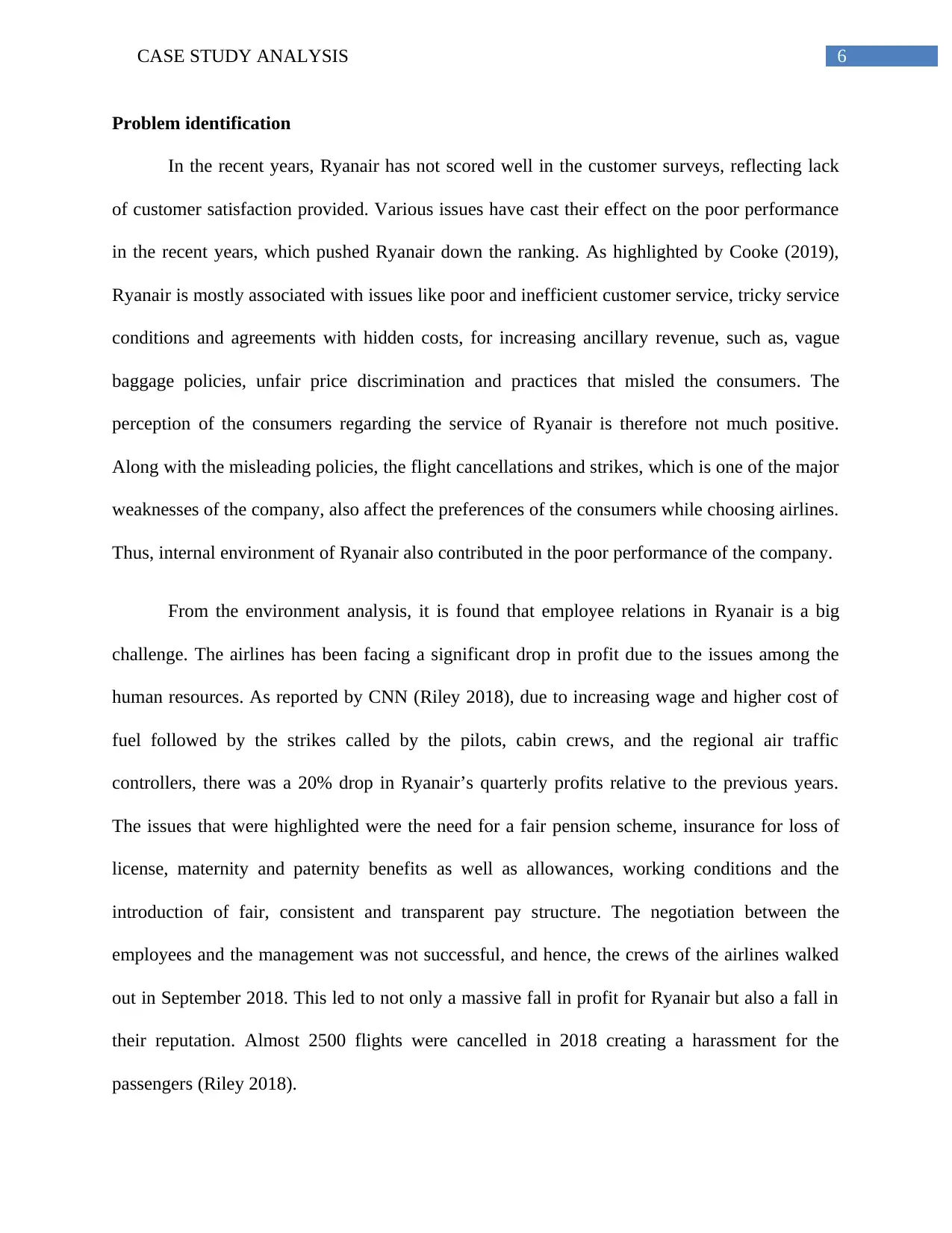
6CASE STUDY ANALYSIS
Problem identification
In the recent years, Ryanair has not scored well in the customer surveys, reflecting lack
of customer satisfaction provided. Various issues have cast their effect on the poor performance
in the recent years, which pushed Ryanair down the ranking. As highlighted by Cooke (2019),
Ryanair is mostly associated with issues like poor and inefficient customer service, tricky service
conditions and agreements with hidden costs, for increasing ancillary revenue, such as, vague
baggage policies, unfair price discrimination and practices that misled the consumers. The
perception of the consumers regarding the service of Ryanair is therefore not much positive.
Along with the misleading policies, the flight cancellations and strikes, which is one of the major
weaknesses of the company, also affect the preferences of the consumers while choosing airlines.
Thus, internal environment of Ryanair also contributed in the poor performance of the company.
From the environment analysis, it is found that employee relations in Ryanair is a big
challenge. The airlines has been facing a significant drop in profit due to the issues among the
human resources. As reported by CNN (Riley 2018), due to increasing wage and higher cost of
fuel followed by the strikes called by the pilots, cabin crews, and the regional air traffic
controllers, there was a 20% drop in Ryanair’s quarterly profits relative to the previous years.
The issues that were highlighted were the need for a fair pension scheme, insurance for loss of
license, maternity and paternity benefits as well as allowances, working conditions and the
introduction of fair, consistent and transparent pay structure. The negotiation between the
employees and the management was not successful, and hence, the crews of the airlines walked
out in September 2018. This led to not only a massive fall in profit for Ryanair but also a fall in
their reputation. Almost 2500 flights were cancelled in 2018 creating a harassment for the
passengers (Riley 2018).
Problem identification
In the recent years, Ryanair has not scored well in the customer surveys, reflecting lack
of customer satisfaction provided. Various issues have cast their effect on the poor performance
in the recent years, which pushed Ryanair down the ranking. As highlighted by Cooke (2019),
Ryanair is mostly associated with issues like poor and inefficient customer service, tricky service
conditions and agreements with hidden costs, for increasing ancillary revenue, such as, vague
baggage policies, unfair price discrimination and practices that misled the consumers. The
perception of the consumers regarding the service of Ryanair is therefore not much positive.
Along with the misleading policies, the flight cancellations and strikes, which is one of the major
weaknesses of the company, also affect the preferences of the consumers while choosing airlines.
Thus, internal environment of Ryanair also contributed in the poor performance of the company.
From the environment analysis, it is found that employee relations in Ryanair is a big
challenge. The airlines has been facing a significant drop in profit due to the issues among the
human resources. As reported by CNN (Riley 2018), due to increasing wage and higher cost of
fuel followed by the strikes called by the pilots, cabin crews, and the regional air traffic
controllers, there was a 20% drop in Ryanair’s quarterly profits relative to the previous years.
The issues that were highlighted were the need for a fair pension scheme, insurance for loss of
license, maternity and paternity benefits as well as allowances, working conditions and the
introduction of fair, consistent and transparent pay structure. The negotiation between the
employees and the management was not successful, and hence, the crews of the airlines walked
out in September 2018. This led to not only a massive fall in profit for Ryanair but also a fall in
their reputation. Almost 2500 flights were cancelled in 2018 creating a harassment for the
passengers (Riley 2018).
Paraphrase This Document
Need a fresh take? Get an instant paraphrase of this document with our AI Paraphraser
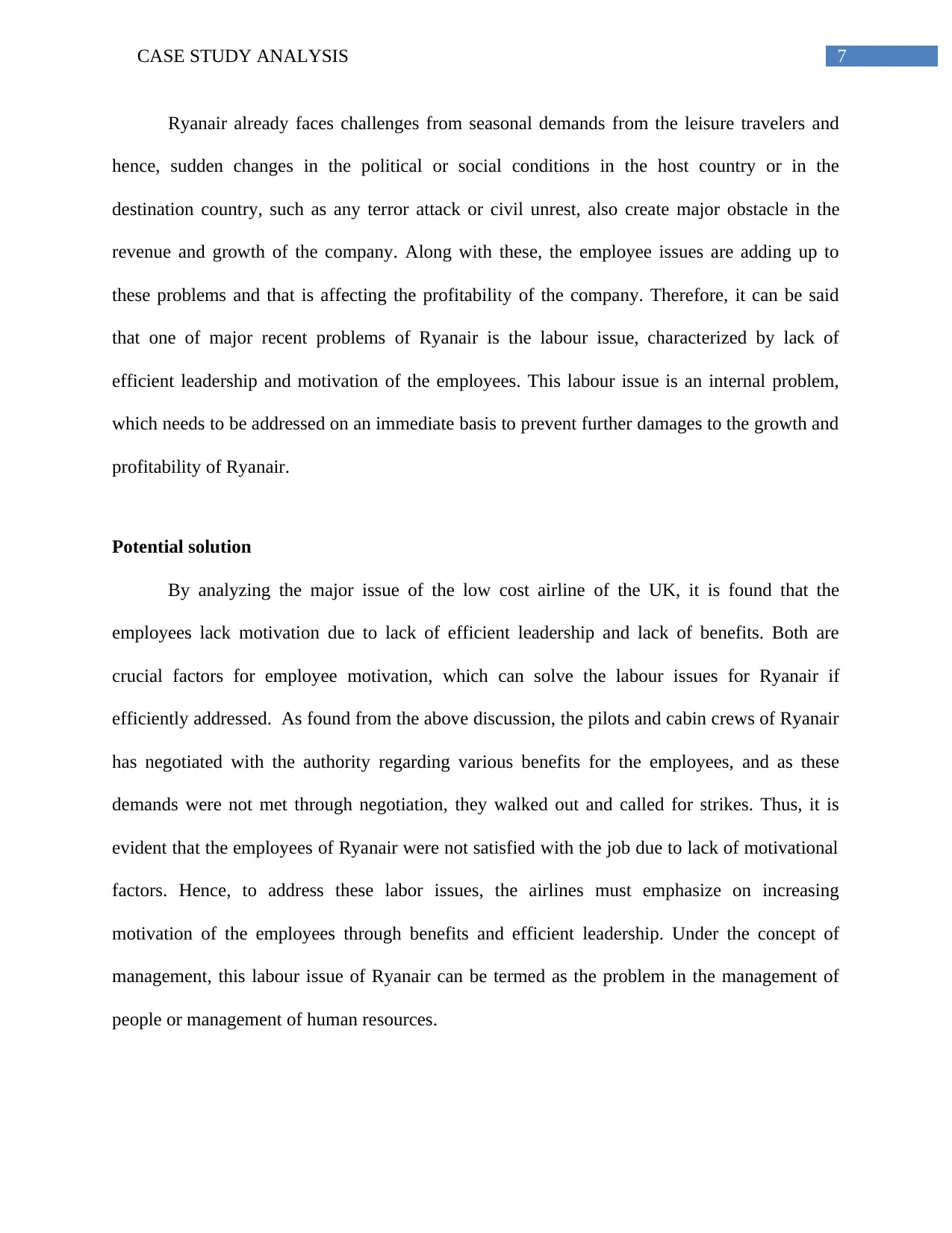
7CASE STUDY ANALYSIS
Ryanair already faces challenges from seasonal demands from the leisure travelers and
hence, sudden changes in the political or social conditions in the host country or in the
destination country, such as any terror attack or civil unrest, also create major obstacle in the
revenue and growth of the company. Along with these, the employee issues are adding up to
these problems and that is affecting the profitability of the company. Therefore, it can be said
that one of major recent problems of Ryanair is the labour issue, characterized by lack of
efficient leadership and motivation of the employees. This labour issue is an internal problem,
which needs to be addressed on an immediate basis to prevent further damages to the growth and
profitability of Ryanair.
Potential solution
By analyzing the major issue of the low cost airline of the UK, it is found that the
employees lack motivation due to lack of efficient leadership and lack of benefits. Both are
crucial factors for employee motivation, which can solve the labour issues for Ryanair if
efficiently addressed. As found from the above discussion, the pilots and cabin crews of Ryanair
has negotiated with the authority regarding various benefits for the employees, and as these
demands were not met through negotiation, they walked out and called for strikes. Thus, it is
evident that the employees of Ryanair were not satisfied with the job due to lack of motivational
factors. Hence, to address these labor issues, the airlines must emphasize on increasing
motivation of the employees through benefits and efficient leadership. Under the concept of
management, this labour issue of Ryanair can be termed as the problem in the management of
people or management of human resources.
Ryanair already faces challenges from seasonal demands from the leisure travelers and
hence, sudden changes in the political or social conditions in the host country or in the
destination country, such as any terror attack or civil unrest, also create major obstacle in the
revenue and growth of the company. Along with these, the employee issues are adding up to
these problems and that is affecting the profitability of the company. Therefore, it can be said
that one of major recent problems of Ryanair is the labour issue, characterized by lack of
efficient leadership and motivation of the employees. This labour issue is an internal problem,
which needs to be addressed on an immediate basis to prevent further damages to the growth and
profitability of Ryanair.
Potential solution
By analyzing the major issue of the low cost airline of the UK, it is found that the
employees lack motivation due to lack of efficient leadership and lack of benefits. Both are
crucial factors for employee motivation, which can solve the labour issues for Ryanair if
efficiently addressed. As found from the above discussion, the pilots and cabin crews of Ryanair
has negotiated with the authority regarding various benefits for the employees, and as these
demands were not met through negotiation, they walked out and called for strikes. Thus, it is
evident that the employees of Ryanair were not satisfied with the job due to lack of motivational
factors. Hence, to address these labor issues, the airlines must emphasize on increasing
motivation of the employees through benefits and efficient leadership. Under the concept of
management, this labour issue of Ryanair can be termed as the problem in the management of
people or management of human resources.
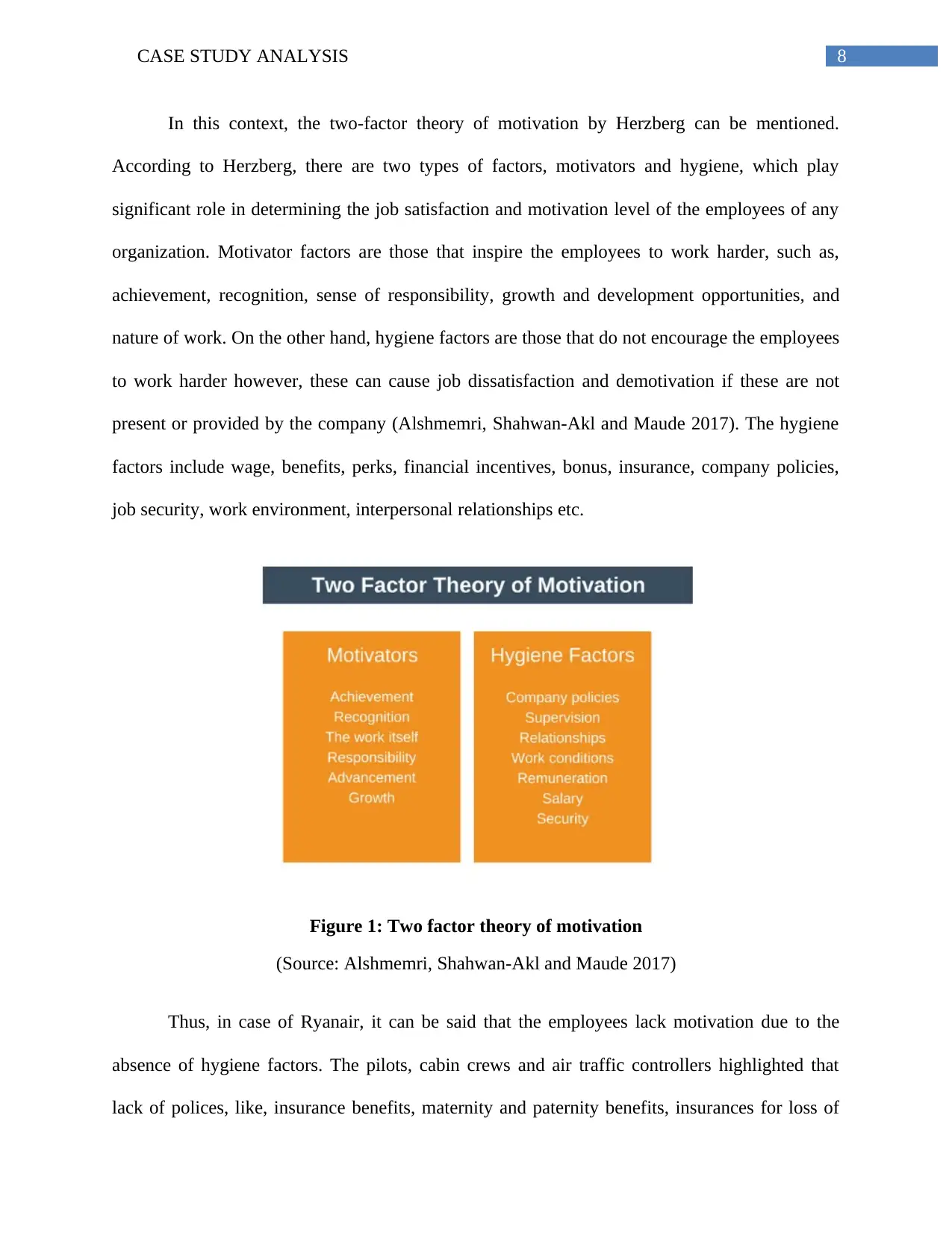
8CASE STUDY ANALYSIS
In this context, the two-factor theory of motivation by Herzberg can be mentioned.
According to Herzberg, there are two types of factors, motivators and hygiene, which play
significant role in determining the job satisfaction and motivation level of the employees of any
organization. Motivator factors are those that inspire the employees to work harder, such as,
achievement, recognition, sense of responsibility, growth and development opportunities, and
nature of work. On the other hand, hygiene factors are those that do not encourage the employees
to work harder however, these can cause job dissatisfaction and demotivation if these are not
present or provided by the company (Alshmemri, Shahwan-Akl and Maude 2017). The hygiene
factors include wage, benefits, perks, financial incentives, bonus, insurance, company policies,
job security, work environment, interpersonal relationships etc.
Figure 1: Two factor theory of motivation
(Source: Alshmemri, Shahwan-Akl and Maude 2017)
Thus, in case of Ryanair, it can be said that the employees lack motivation due to the
absence of hygiene factors. The pilots, cabin crews and air traffic controllers highlighted that
lack of polices, like, insurance benefits, maternity and paternity benefits, insurances for loss of
In this context, the two-factor theory of motivation by Herzberg can be mentioned.
According to Herzberg, there are two types of factors, motivators and hygiene, which play
significant role in determining the job satisfaction and motivation level of the employees of any
organization. Motivator factors are those that inspire the employees to work harder, such as,
achievement, recognition, sense of responsibility, growth and development opportunities, and
nature of work. On the other hand, hygiene factors are those that do not encourage the employees
to work harder however, these can cause job dissatisfaction and demotivation if these are not
present or provided by the company (Alshmemri, Shahwan-Akl and Maude 2017). The hygiene
factors include wage, benefits, perks, financial incentives, bonus, insurance, company policies,
job security, work environment, interpersonal relationships etc.
Figure 1: Two factor theory of motivation
(Source: Alshmemri, Shahwan-Akl and Maude 2017)
Thus, in case of Ryanair, it can be said that the employees lack motivation due to the
absence of hygiene factors. The pilots, cabin crews and air traffic controllers highlighted that
lack of polices, like, insurance benefits, maternity and paternity benefits, insurances for loss of
⊘ This is a preview!⊘
Do you want full access?
Subscribe today to unlock all pages.

Trusted by 1+ million students worldwide
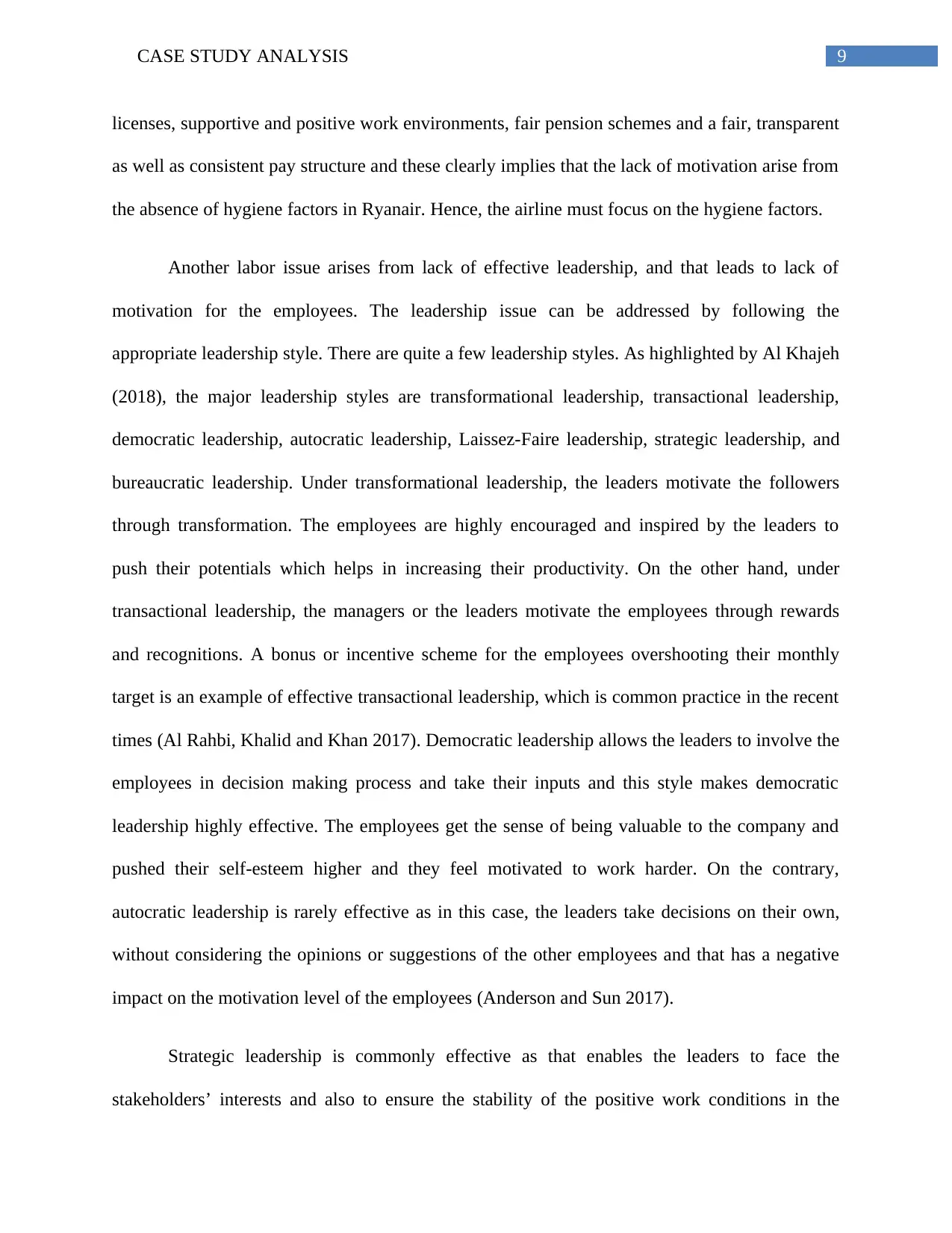
9CASE STUDY ANALYSIS
licenses, supportive and positive work environments, fair pension schemes and a fair, transparent
as well as consistent pay structure and these clearly implies that the lack of motivation arise from
the absence of hygiene factors in Ryanair. Hence, the airline must focus on the hygiene factors.
Another labor issue arises from lack of effective leadership, and that leads to lack of
motivation for the employees. The leadership issue can be addressed by following the
appropriate leadership style. There are quite a few leadership styles. As highlighted by Al Khajeh
(2018), the major leadership styles are transformational leadership, transactional leadership,
democratic leadership, autocratic leadership, Laissez-Faire leadership, strategic leadership, and
bureaucratic leadership. Under transformational leadership, the leaders motivate the followers
through transformation. The employees are highly encouraged and inspired by the leaders to
push their potentials which helps in increasing their productivity. On the other hand, under
transactional leadership, the managers or the leaders motivate the employees through rewards
and recognitions. A bonus or incentive scheme for the employees overshooting their monthly
target is an example of effective transactional leadership, which is common practice in the recent
times (Al Rahbi, Khalid and Khan 2017). Democratic leadership allows the leaders to involve the
employees in decision making process and take their inputs and this style makes democratic
leadership highly effective. The employees get the sense of being valuable to the company and
pushed their self-esteem higher and they feel motivated to work harder. On the contrary,
autocratic leadership is rarely effective as in this case, the leaders take decisions on their own,
without considering the opinions or suggestions of the other employees and that has a negative
impact on the motivation level of the employees (Anderson and Sun 2017).
Strategic leadership is commonly effective as that enables the leaders to face the
stakeholders’ interests and also to ensure the stability of the positive work conditions in the
licenses, supportive and positive work environments, fair pension schemes and a fair, transparent
as well as consistent pay structure and these clearly implies that the lack of motivation arise from
the absence of hygiene factors in Ryanair. Hence, the airline must focus on the hygiene factors.
Another labor issue arises from lack of effective leadership, and that leads to lack of
motivation for the employees. The leadership issue can be addressed by following the
appropriate leadership style. There are quite a few leadership styles. As highlighted by Al Khajeh
(2018), the major leadership styles are transformational leadership, transactional leadership,
democratic leadership, autocratic leadership, Laissez-Faire leadership, strategic leadership, and
bureaucratic leadership. Under transformational leadership, the leaders motivate the followers
through transformation. The employees are highly encouraged and inspired by the leaders to
push their potentials which helps in increasing their productivity. On the other hand, under
transactional leadership, the managers or the leaders motivate the employees through rewards
and recognitions. A bonus or incentive scheme for the employees overshooting their monthly
target is an example of effective transactional leadership, which is common practice in the recent
times (Al Rahbi, Khalid and Khan 2017). Democratic leadership allows the leaders to involve the
employees in decision making process and take their inputs and this style makes democratic
leadership highly effective. The employees get the sense of being valuable to the company and
pushed their self-esteem higher and they feel motivated to work harder. On the contrary,
autocratic leadership is rarely effective as in this case, the leaders take decisions on their own,
without considering the opinions or suggestions of the other employees and that has a negative
impact on the motivation level of the employees (Anderson and Sun 2017).
Strategic leadership is commonly effective as that enables the leaders to face the
stakeholders’ interests and also to ensure the stability of the positive work conditions in the
Paraphrase This Document
Need a fresh take? Get an instant paraphrase of this document with our AI Paraphraser
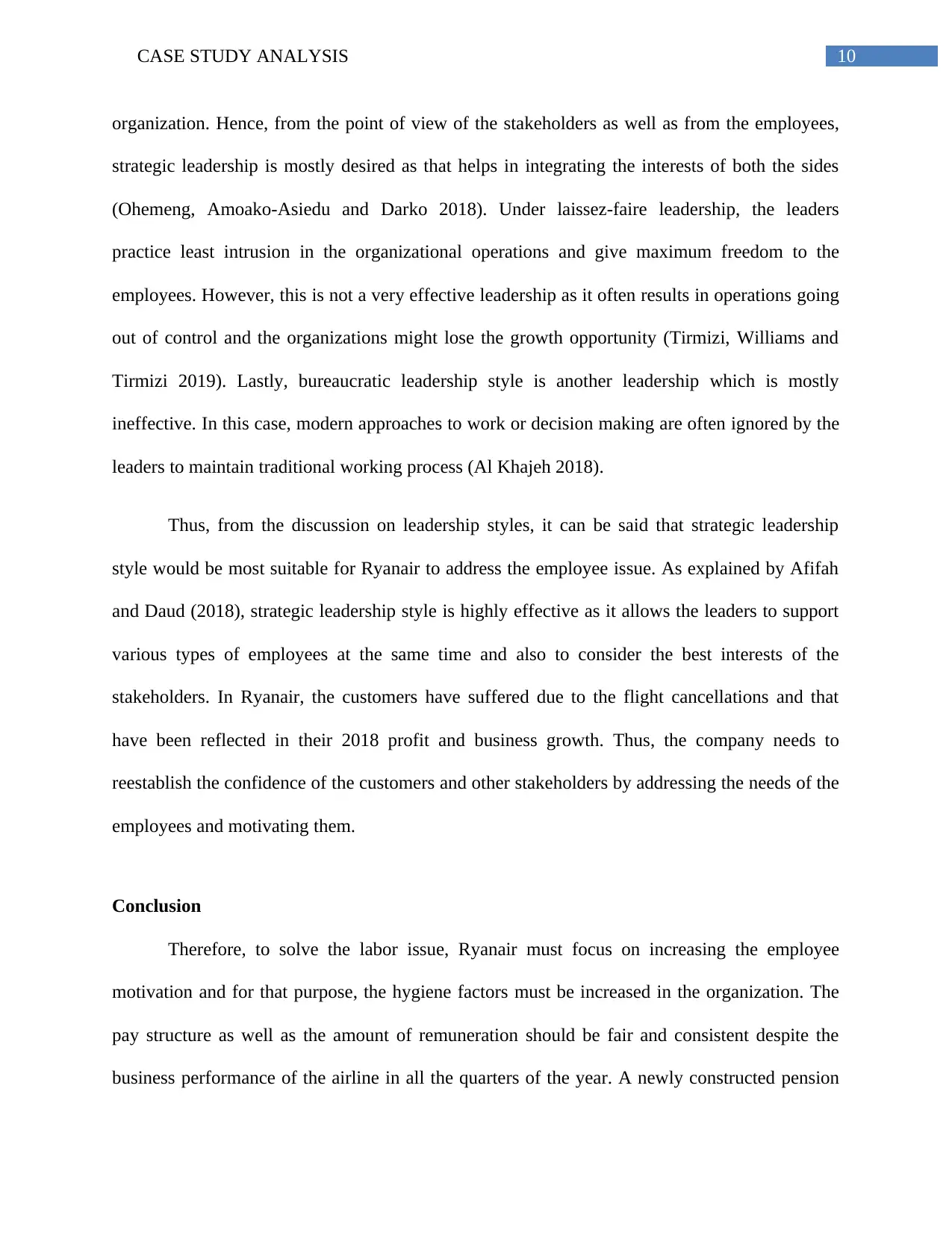
10CASE STUDY ANALYSIS
organization. Hence, from the point of view of the stakeholders as well as from the employees,
strategic leadership is mostly desired as that helps in integrating the interests of both the sides
(Ohemeng, Amoako-Asiedu and Darko 2018). Under laissez-faire leadership, the leaders
practice least intrusion in the organizational operations and give maximum freedom to the
employees. However, this is not a very effective leadership as it often results in operations going
out of control and the organizations might lose the growth opportunity (Tirmizi, Williams and
Tirmizi 2019). Lastly, bureaucratic leadership style is another leadership which is mostly
ineffective. In this case, modern approaches to work or decision making are often ignored by the
leaders to maintain traditional working process (Al Khajeh 2018).
Thus, from the discussion on leadership styles, it can be said that strategic leadership
style would be most suitable for Ryanair to address the employee issue. As explained by Afifah
and Daud (2018), strategic leadership style is highly effective as it allows the leaders to support
various types of employees at the same time and also to consider the best interests of the
stakeholders. In Ryanair, the customers have suffered due to the flight cancellations and that
have been reflected in their 2018 profit and business growth. Thus, the company needs to
reestablish the confidence of the customers and other stakeholders by addressing the needs of the
employees and motivating them.
Conclusion
Therefore, to solve the labor issue, Ryanair must focus on increasing the employee
motivation and for that purpose, the hygiene factors must be increased in the organization. The
pay structure as well as the amount of remuneration should be fair and consistent despite the
business performance of the airline in all the quarters of the year. A newly constructed pension
organization. Hence, from the point of view of the stakeholders as well as from the employees,
strategic leadership is mostly desired as that helps in integrating the interests of both the sides
(Ohemeng, Amoako-Asiedu and Darko 2018). Under laissez-faire leadership, the leaders
practice least intrusion in the organizational operations and give maximum freedom to the
employees. However, this is not a very effective leadership as it often results in operations going
out of control and the organizations might lose the growth opportunity (Tirmizi, Williams and
Tirmizi 2019). Lastly, bureaucratic leadership style is another leadership which is mostly
ineffective. In this case, modern approaches to work or decision making are often ignored by the
leaders to maintain traditional working process (Al Khajeh 2018).
Thus, from the discussion on leadership styles, it can be said that strategic leadership
style would be most suitable for Ryanair to address the employee issue. As explained by Afifah
and Daud (2018), strategic leadership style is highly effective as it allows the leaders to support
various types of employees at the same time and also to consider the best interests of the
stakeholders. In Ryanair, the customers have suffered due to the flight cancellations and that
have been reflected in their 2018 profit and business growth. Thus, the company needs to
reestablish the confidence of the customers and other stakeholders by addressing the needs of the
employees and motivating them.
Conclusion
Therefore, to solve the labor issue, Ryanair must focus on increasing the employee
motivation and for that purpose, the hygiene factors must be increased in the organization. The
pay structure as well as the amount of remuneration should be fair and consistent despite the
business performance of the airline in all the quarters of the year. A newly constructed pension
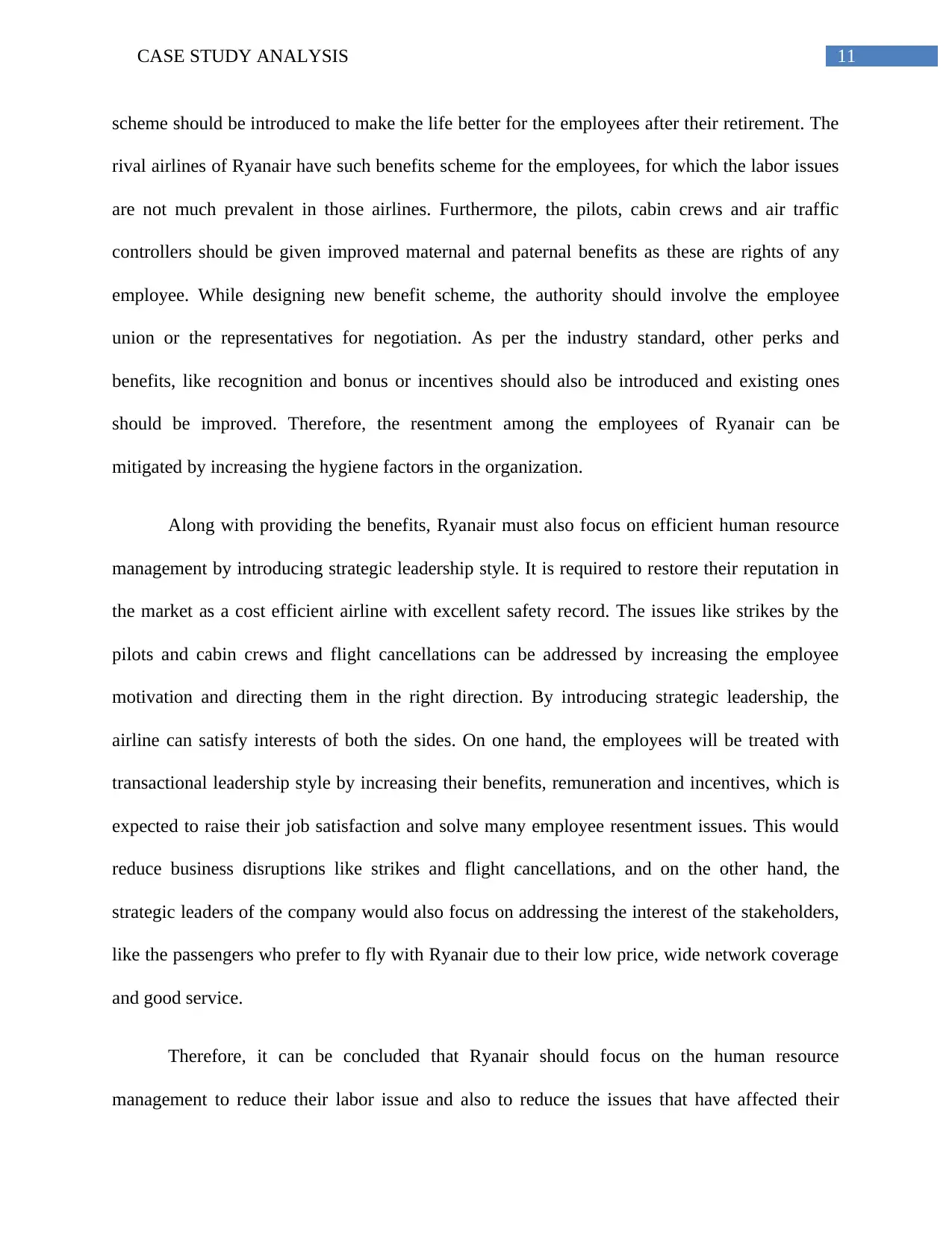
11CASE STUDY ANALYSIS
scheme should be introduced to make the life better for the employees after their retirement. The
rival airlines of Ryanair have such benefits scheme for the employees, for which the labor issues
are not much prevalent in those airlines. Furthermore, the pilots, cabin crews and air traffic
controllers should be given improved maternal and paternal benefits as these are rights of any
employee. While designing new benefit scheme, the authority should involve the employee
union or the representatives for negotiation. As per the industry standard, other perks and
benefits, like recognition and bonus or incentives should also be introduced and existing ones
should be improved. Therefore, the resentment among the employees of Ryanair can be
mitigated by increasing the hygiene factors in the organization.
Along with providing the benefits, Ryanair must also focus on efficient human resource
management by introducing strategic leadership style. It is required to restore their reputation in
the market as a cost efficient airline with excellent safety record. The issues like strikes by the
pilots and cabin crews and flight cancellations can be addressed by increasing the employee
motivation and directing them in the right direction. By introducing strategic leadership, the
airline can satisfy interests of both the sides. On one hand, the employees will be treated with
transactional leadership style by increasing their benefits, remuneration and incentives, which is
expected to raise their job satisfaction and solve many employee resentment issues. This would
reduce business disruptions like strikes and flight cancellations, and on the other hand, the
strategic leaders of the company would also focus on addressing the interest of the stakeholders,
like the passengers who prefer to fly with Ryanair due to their low price, wide network coverage
and good service.
Therefore, it can be concluded that Ryanair should focus on the human resource
management to reduce their labor issue and also to reduce the issues that have affected their
scheme should be introduced to make the life better for the employees after their retirement. The
rival airlines of Ryanair have such benefits scheme for the employees, for which the labor issues
are not much prevalent in those airlines. Furthermore, the pilots, cabin crews and air traffic
controllers should be given improved maternal and paternal benefits as these are rights of any
employee. While designing new benefit scheme, the authority should involve the employee
union or the representatives for negotiation. As per the industry standard, other perks and
benefits, like recognition and bonus or incentives should also be introduced and existing ones
should be improved. Therefore, the resentment among the employees of Ryanair can be
mitigated by increasing the hygiene factors in the organization.
Along with providing the benefits, Ryanair must also focus on efficient human resource
management by introducing strategic leadership style. It is required to restore their reputation in
the market as a cost efficient airline with excellent safety record. The issues like strikes by the
pilots and cabin crews and flight cancellations can be addressed by increasing the employee
motivation and directing them in the right direction. By introducing strategic leadership, the
airline can satisfy interests of both the sides. On one hand, the employees will be treated with
transactional leadership style by increasing their benefits, remuneration and incentives, which is
expected to raise their job satisfaction and solve many employee resentment issues. This would
reduce business disruptions like strikes and flight cancellations, and on the other hand, the
strategic leaders of the company would also focus on addressing the interest of the stakeholders,
like the passengers who prefer to fly with Ryanair due to their low price, wide network coverage
and good service.
Therefore, it can be concluded that Ryanair should focus on the human resource
management to reduce their labor issue and also to reduce the issues that have affected their
⊘ This is a preview!⊘
Do you want full access?
Subscribe today to unlock all pages.

Trusted by 1+ million students worldwide
1 out of 17
Related Documents
Your All-in-One AI-Powered Toolkit for Academic Success.
+13062052269
info@desklib.com
Available 24*7 on WhatsApp / Email
![[object Object]](/_next/static/media/star-bottom.7253800d.svg)
Unlock your academic potential
Copyright © 2020–2025 A2Z Services. All Rights Reserved. Developed and managed by ZUCOL.




